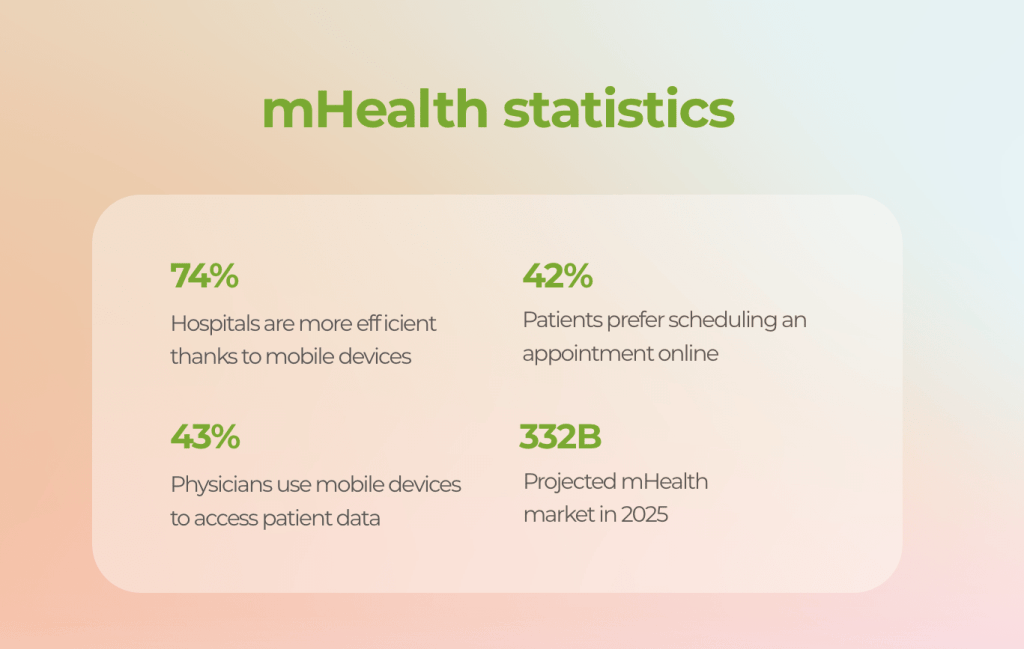Healthcare app development is a massive global industry growing steadily. There are over 40,000 healthcare apps available on Apple’s App Store and Play Store for Android users. Moreover, the market for telemedicine apps is slated to grow to $18 billion within the next five years. As if that’s not enough, mobile medical app development bagged over $10 billion in funding in the last couple of years. To sum it up, health app development has become an integral part of the broader healthcare IT industry.

Today, siloed healthcare applications don’t cut it anymore unless they integrate with other clinical software, e.g., electronic health record systems or clinical decision support solutions. Health data needs to flow freely and securely between different digital products to enable better outcomes for patients. That’s where Fast Healthcare Interoperability Resources (FHIR)comes in. Health Level Seven International managed to partially solve interoperability by releasing SMART on FHIR, the modern information exchange protocol. What is SMART on FHIR?
What is SMART on FHIR?
In order to offer safe, open access to EHRs, SMART is an open-source, standards-based API that makes use of the OAuth 2.0 standard. The Fast Health Interoperability Resources- HL7 FHIR serve as a foundation for the SMART platform (hence the name “SMART on FHIR”).
Together, these two standards provide programmers with all the tools they need to create apps that may be used throughout the healthcare ecosystem:
- Universal access to EHRs can be built into applications using open standards for protocols for authentication, authorization, and UI integration.
- The adoption of SMART standards while developing applications is facilitated by open-source tools and libraries for developers. The platform also provides a free sandbox to developers so they may test their applications before releasing them.
- An application gallery that showcases all of the SMART-using healthcare programs and applications that are now available on the FHIR platform
SMART Improves Healthcare Interoperability and Delivery
Most EHR databases today employ a proprietary API (their own unique plug and socket configuration). In order to access medical data, IT businesses must create a unique connection to each database. This is not only expensive, but it also makes it difficult for patients and healthcare professionals to access their data using the technology that suits them best.
On the other hand, SMART offers a uniform, industry-standard API for EHR access. Any SMART-built technology is compatible with any EHR database that also uses SMART. As a result, medical technology becomes interchangeable, enabling health systems and patients to access medical data on the applications that best meet their needs as opposed to just those that integrate with the EHR database.
The Role of SMART on FHIR in Health App Development
When do you need SMART on FHIR? This technology standard comes into play when you develop a healthcare application that uses protected health information (PHI), pulling or sharing it with other external systems. In 99% of cases, that’s a health app integrated with an EHR/EMR system, or a patient app/portal, or a clinical data warehouse.
Building your app using SMART on FHIR, you’re making your health app future-proof as it will be much easier to integrate it with other applications. Let’s briefly review other advantages of SMART on FHIR integration.
How Does SMART on FHIR Work?
SMART on FHIR developers would need to implement a few industry standards according to the specifications, using the REST-based APIs:
- OAuth
- OpenID
The technology presents two variants of working with health apps that need to integrate with EHR systems:
- standalone apps that launch independently from the EHR
- apps that run right inside the EHR’s interface
Of course, to launch a health app from inside an EHR system, it needs to support SMART on FHIR.
SMART on FHIR API enables the development of various applications:
- iOS, iPadOS, and WatchOS apps
- Android apps
- Epic, Cerner, Allscripts, and other EHR vendors
- Google and Microsoft provide SMART on FHIR-ready cloud services
60.2% of digital health builders in a recent survey are likely to use the FHIR industry standard for their own application development or infrastructure decisions
Without SMART on FHIR, implementing all of the aforementioned was challenging. It has to be manually done to establish dependencies and synchronize the app with a particular healthcare provider’s EHR.
How to build Interoperable Healthcare App
1. App Type Choice
A multi-platform healthcare app is necessary for interoperability. It can be used as an integrated system or as a standalone system. For instance, you may design a mobile app for regular users and a web platform with access to patient information for doctors.
To enable integration into any app, SMART on FHIR is developed as an API that supports RESTful and HTTP services in addition to JSON or XML data formats. Due to improved protocol compatibility, it is preferred to use JAVA-oriented frameworks like Angular, React, or Node.
2. Security and Certification Standards
A protocol for interacting between clients and medical systems is called SMART on FHIR. However, do not overlook the importance of certifications and standards like GDPR, HIPAA, ICD-10, XDS, XDS-I, and EVV for the healthcare industry.
You must adhere to these requirements for your IT product in order for the app to function with healthcare providers. When ordering development and creating technical requirements for the contractor, take it into account.
3. Including Vendor Integration
SMART on FHIR support should be taken into account while connecting your app to EHR and EMR platforms. This protocol is supported, for instance, by Epic, Allscripts, Cerner, and Orion Health. Onc in the US, NHI in the UK, HINZ in New Zealand, and NEHTA in Australia are more organizations that support it.
4. Testing
You can test the performance of your IT product before deployment using the SMART APP Launcher platform. On the basis of this API, certain healthcare providers offer their test environments. They replicate their EHR data or even present material that is true. As a result, the functionality of notification systems as well as the application logic and interface components are examined.
5. Deployment
If your IT solution supports FHIR and you have a native app, you can publish it on specialist websites like Google Market or the AppStore. You can use cloud platforms to host an online product. A number of vendors, including Google, Amazon, Verily, Azure, and others, enable SMART on FHIR. Visit Cerner, a profile website with many SMART on FHIR applications. By the way, you can use this platform to deploy IT solutions for publishing or testing.
Why is SMART on FHIR relevant now?
•The 21st century cures act has called for the adoption of an unspecific API.
•Recent CMS and ONC rules have already made SMART on FHIR capabilities on EHR/provider/payer mandatory.
•The Office of the National Coordinator for Health Information Technology’s (ONC’s) Final Rule on Interoperability (Published in 2020) has later named SMART as a communication standard.
•Given the benefits and these recent regulations from the government, it is imperative that every major EHR vendor and other third-party organizations adopt SMART on FHIR. So, now you can choose to either stay with the crowd or become obsolete.
Take the SMART-er step.
Interoperable apps for healthcare and medical services based on SMART on FHIR are a trend for the next decade.
KPi-Tech’s healthcare IT team has the expertise and experience of working in the US healthcare ecosystem for more than a decade now. We can help you with Mobile Application Development compatible with SMART on FHIR, keeping in mind your requirements. If you’d like to discuss how SMART on FHIR can help you set up interoperability in your family of healthcare apps, reach out today. We’ll be happy to elaborate on how this technology can help you put patient data to use and transition to value-based healthcare.
Kishore Pendyala has more than 18 years of experience in the Healthcare IT domain. He prides himself on understanding the complexities of enterprise business as well as the intricacies of running a small company. He has worn many hats (often at the same time) throughout his career including data analyst, product owner, business analyst, software engineer, team leader, QA engineer, and probably several others he’s forgotten. Out of all of this, he’s discovered his passion is really in identifying simple and effective solutions to the Healthcare Interoperability issues. This has driven his leadership at KP-Tech Services as CEO and co-founder and has proven to be sustainable, and productive for the company.







